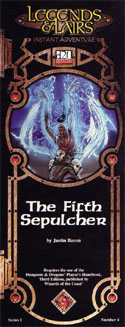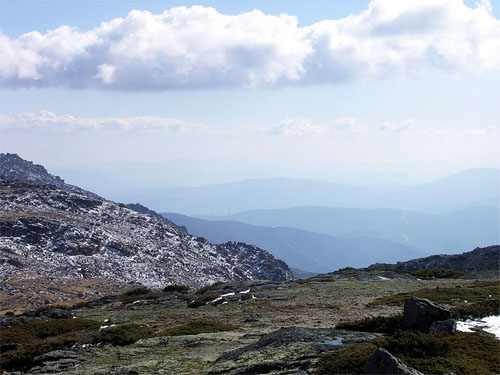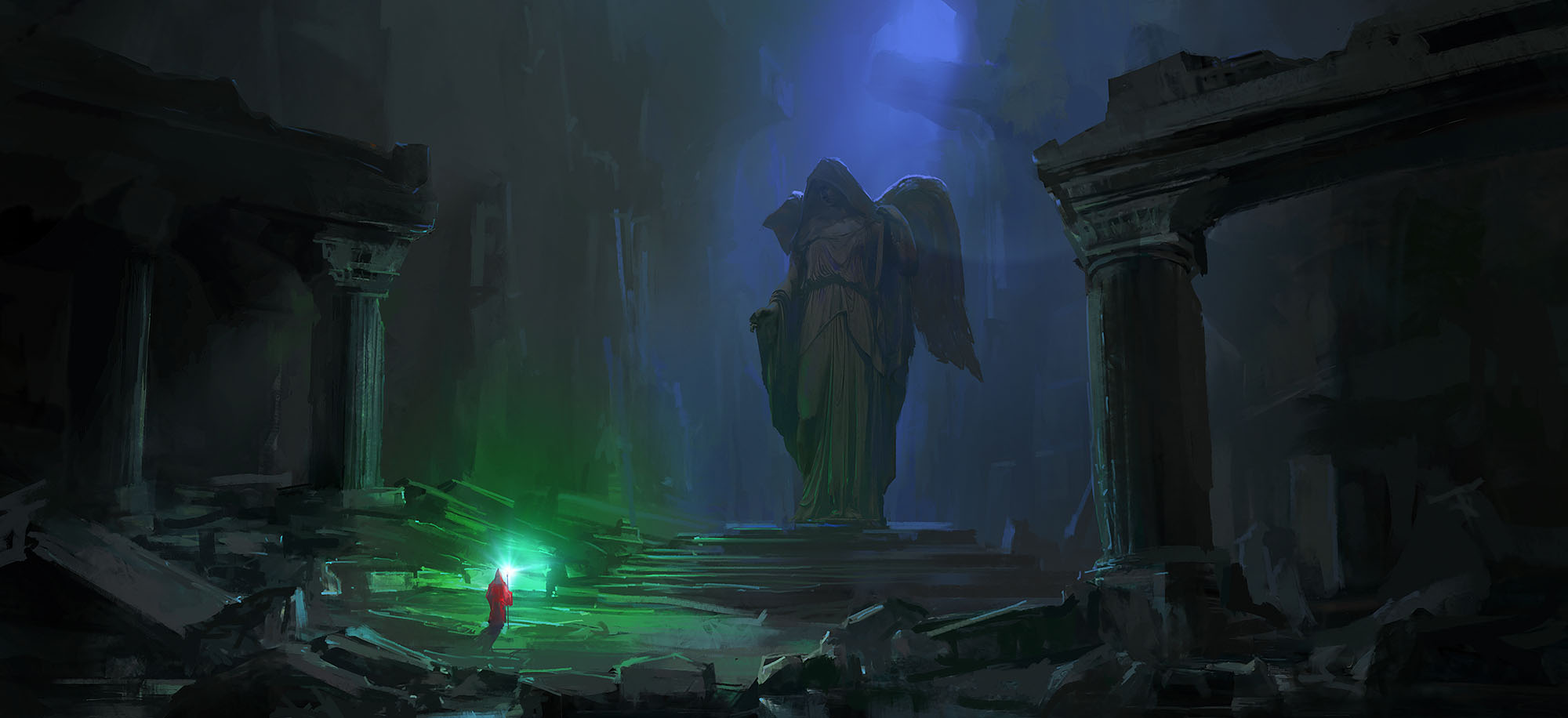 So, here’s a semi-interesting thing. When I posted about one of the gilted fiends being used in a Redditor’s D&D game, my rambling thoughts led me to post an excerpt from The Fifth Sepulcher, a D20 adventure that I wrote for Fantasy Flight Games back in 2001. In order to pull that excerpt, I did a quick search on my computer to pull up my original draft of the adventure. But I also ended up inadvertently stumbling across something that I had completely forgotten about: The soundtrack I assembled when I originally playtested The Fifth Sepulcher.
So, here’s a semi-interesting thing. When I posted about one of the gilted fiends being used in a Redditor’s D&D game, my rambling thoughts led me to post an excerpt from The Fifth Sepulcher, a D20 adventure that I wrote for Fantasy Flight Games back in 2001. In order to pull that excerpt, I did a quick search on my computer to pull up my original draft of the adventure. But I also ended up inadvertently stumbling across something that I had completely forgotten about: The soundtrack I assembled when I originally playtested The Fifth Sepulcher.
A little over a decade ago I started prepping specific tracks cued to specific sequences in the adventures I was prepping. I would also take the playlists, burn copies of the adventure’s “soundtrack”, and give them to the players as gifts. (Often including CD cases, cover art, and the whole nine yards.) My players generally seemed to enjoy the result. A couple of tips from that experience if you should choose to duplicate it:
Tip #1 – A Big Pitfall: “Wow, this 2 minute track sounds perfect for the fight with the cultists!” Then the fight takes 40 minutes to resolve and everyone is really, really sick of that 2 minute track.
Tip #2: If you’re going to do this, it helps to have a music player with a remote control and a large display that you can see from across the room. (You don’t want the player right next to you, because some players will struggle to hear you over the music if you’re both coming from the same direction.)
Tip #3: Try to avoid well-known and easily recognizable music that your players are familiar with. They’ll associate it with the source instead of the adventure, and that can often lead to additional distractions. (Unless, of course, you specifically want to create and benefit from those associations.)
Over time, I’ve moved away from this kind of specificity and instead prep generic playlists for my iPod. At the moment, for example, I’ve got four primary playlists that I use for D&D:
- D&D Generic Background
- D&D Generic City
- D&D Generic Combat
- D&D Epic Combat
Whenever I add a new CD or soundtrack to my collection, I go through it track by track and add songs to the appropriate playlists. At the moment, for example, there are 4.8 hours worth of music in my D&D Generic Combat playlist.
What I’ve found is that this light theming is pretty much wholly equivalent in terms of effectiveness compared to the track-by-track prep I was doing before. Plus, it’s prep-once-and-reuse-forever instead of requiring a heavy prep load for every session.
Of course, even within this structure you can also move beyond the purely generic. For example, I’ve prepped a separate playlist for the two major Bad Guy Organizations in my regular campaign: So when the party is fighting Group A it sounds different than when they’re fighting Group B (and also sounds different from the Generic Combat playlist). It’s a subtle distinction, but over time I think it’s effective in building up musical associations.
But I digress. Without further ado, here’s the “official soundtrack” for The Fifth Sepulcher:
THE FIFTH SEPULCHER – SOUNDTRACK
The First Sepulcher
1. Lynmoor (Vampire Princess Miyu, Track 8, In the Ancient Capital)
2. King Alexir IV (Vampire Princess Miyu, Track 13, Larva’s Theme)
3. The First Sepulcher (Ultima Online, Stones)
4. Chathar’s Fists (Escaflowne, Disc 2, Track 10)
5. The Wight’s Howl (Quest for the Seals, Track 16, Enter the Creature)
6. Shadows of the Dead (Metal Gear Solid, Track 8, Warhead Storage)
7. The Crypts of Kings (Kenshin: OST 2, Track 13, Departure)
The Second Sepulcher
8. Down Into the Depths (Vampire Princess Miyu, Track 1, Opening Theme)
9. The Hall of Horrors (Dungeons & Dragons, Track 8, Thieves’ Fight)
10. Haradik’s Legions (Dungeons & Dragons, Track 4, On the Run)
11. Haradik’s Giants (Vampire Princess Miyu, Track 6, Shinma Makes Its Appearance)
The Third Sepulcher
12. The Seven Daughters of Lynmoor (Dungeons & Dragons, Track 2, Council of the Mages)
13. The Crypt of Fiends (Dungeons & Dragons, Track 7, The Maze)
14. The Virgin’s Death (Noir, Track 16, Sorrow)
15. Ghost Howl (Diablo II, Cave)
The Fourth Sepulcher
16. The Hall of Armor (Vampire Princess Miyu, Track 11, Attack of the Armored Apariti)
17. The Death of Kings (Kenshin: OST 2, Track 4, Departure Acoustic)
The Fifth Sepulcher
18. Vanal’s Hall (Ultima Online, Vesper)
19. The Hall of Wraiths (Three Days to Kill, Track 14, Battle Royale)
20. The Crypt of Vanal (Remastered UO, Swamp)
21. The Necromancer’s Stone (Kenshin: OST 3, Track 11, Warrior’s Suite)
22. The Heroes Triumphant (Noir, Track 4, Canta Per Me)
(I have to apologize for one of these tracks: Track 5 refers to the “Quest of the Seals” soundtrack. This is actually a soundtrack that was prepped for my first 3rd Edition campaign by one of my players. Unfortunately, she didn’t label the source for any of the tracks. I appear to have since lost that CD myself, so even I can’t fully re-create this track listing.)
SOUNDTRACK GUIDE
Introduction: Track 2
Area 1: Track 3
Area 2: Track 4
Area 3: Track 3
Area 4: Track 5 – Combat: Track 5 (then to Track 3)
Area 5: Track 6 (30 seconds to juicy shadow stuff)
Area 6: Track 7
Area 7: Track 8
Area 8: Track 7
Area 9: Track 3 – Combat: Track 9
Area 10: Track 3
Area 11: Track 10 (startle them); to Track 3; to Track 11 (when giants attack)
Area 12: Track 12
Area 13: Track 13 – After Combat: Track 14
Area 14: Track 8 – Shadow Mastiffs: Track 15; After Combat: Track 8
Area 15: Track 8
Area 16: Track 16
Area 17/18/19/20: Track 17
Area 21/22: Track 18 – Wraiths Attack: Track 19
Area 23/24/25/26/27: Track 20 – Devourers: Track 19
Vanal Final Combat: Track 21
After Vanal: Track 22
FURTHER READING
Music in Roleplaying Games
Sunless Citadel – Unofficial Soundtrack
 Had a quick thought for handling bribes last night as I was slipping off into sleep:
Had a quick thought for handling bribes last night as I was slipping off into sleep:















